
Programming .NET Security Adam Freeman, Allen Jones




- Autorzy:
- Adam Freeman, Allen Jones
- Ocena:
- Bądź pierwszym, który oceni tę książkę
- Stron:
- 718
- Dostępne formaty:
-
ePubMobi
 opcje wysyłki »
opcje wysyłki »
Opis
książki
:
Programming .NET Security
With the spread of web-enabled desktop clients and web-server based applications, developers can no longer afford to treat security as an afterthought. It's one topic, in fact, that .NET forces you to address, since Microsoft has placed security-related features at the core of the .NET Framework. Yet, because a developer's carelessness or lack of experience can still allow a program to be used in an unintended way, Programming .NET Security shows you how the various tools will help you write secure applications.The book works as both a comprehensive tutorial and reference to security issues for .NET application development, and contains numerous practical examples in both the C# and VB.NET languages. With Programming .NET Security, you will learn to apply sound security principles to your application designs, and to understand the concepts of identity, authentication and authorization and how they apply to .NET security. This guide also teaches you to:
- use the .NET run-time security features and .NET security namespaces and types to implement best-practices in your applications, including evidence, permissions, code identity and security policy, and role based and Code Access Security (CAS) use the .NET cryptographic APIs , from hashing and common encryption algorithms to digital signatures and cryptographic keys, to protect your data.
- use COM+ component services in a secure manner
Wybrane bestsellery
-
Nowość Promocja
 Oddajemy Czytelnikowi nowe, zaktualizowane i uzupełnione wydanie książki prezentującej możliwości Kali Linux w zakresie testowania bezpieczeństwa oprogramowania. Poza opisem samego systemu i dostępnych narzędzi w wyczerpujący sposób przedstawiono tu szczegóły prowadzenia testów bezpieczeństwa, w tym sieci bezprzewodowych. Omówiono zasady testowania aplikacji WWW, techniki łamania haseł i korzystania z eksploitów. W tym wydaniu znalazły się również bezcenne wskazówki dotyczące analizy oprogramowania z wykorzystaniem inżynierii wstecznej i śledzenia nadużyć cyfrowych. Nie zabrakło też kluczowych dla każdego pentestera kwestii etyki i legalności podejmowanych działań.
Oddajemy Czytelnikowi nowe, zaktualizowane i uzupełnione wydanie książki prezentującej możliwości Kali Linux w zakresie testowania bezpieczeństwa oprogramowania. Poza opisem samego systemu i dostępnych narzędzi w wyczerpujący sposób przedstawiono tu szczegóły prowadzenia testów bezpieczeństwa, w tym sieci bezprzewodowych. Omówiono zasady testowania aplikacji WWW, techniki łamania haseł i korzystania z eksploitów. W tym wydaniu znalazły się również bezcenne wskazówki dotyczące analizy oprogramowania z wykorzystaniem inżynierii wstecznej i śledzenia nadużyć cyfrowych. Nie zabrakło też kluczowych dla każdego pentestera kwestii etyki i legalności podejmowanych działań.- PDF + ePub + Mobi
- Druk 65 pkt
(59,50 zł najniższa cena z 30 dni)
65.45 zł
119.00 zł (-45%) -
Nowość Promocja
 Jeśli chodzi o cyberbezpieczeństwo, żadna firma nie jest bezpieczna. Pytanie, które należy sobie zadać, nie brzmi: czy zostaniemy zaatakowani? Odpowiedź na nie jest bowiem oczywista: tak, zostaniecie zaatakowani. Właściwe pytania są takie: Skąd będziemy wiedzieć, że zostaliśmy zaatakowani? Co wówczas zrobimy?
Jeśli chodzi o cyberbezpieczeństwo, żadna firma nie jest bezpieczna. Pytanie, które należy sobie zadać, nie brzmi: czy zostaniemy zaatakowani? Odpowiedź na nie jest bowiem oczywista: tak, zostaniecie zaatakowani. Właściwe pytania są takie: Skąd będziemy wiedzieć, że zostaliśmy zaatakowani? Co wówczas zrobimy?- PDF + ePub + Mobi
- Druk 43 pkt
(37,89 zł najniższa cena z 30 dni)
43.45 zł
79.00 zł (-45%) -
Nowość Promocja
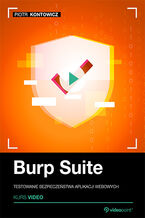 Czy wiesz, co trzeba zrobić, aby odkryć ukryte słabości aplikacji i sprawdzić, jak naprawdę wygląda bezpieczeństwo w Internecie? Tu z pomocą przychodzi Burp Suite, jedno z najważniejszych narzędzi w testach penetracyjnych, które od lat wyznacza standard w cyberbezpieczeństwie. Dzięki swojej kompleksowości pozwala nie tylko przechwytywać i modyfikować ruch HTTP, ale także wykrywać podatności i wykonywać ręczne ataki. To właśnie od Burp Suite zaczyna większość osób, które marzą o karierze pentestera i chcą poznać tajniki etycznego hakingu. Darmowa wersja Community daje każdemu możliwość nauki na realnych podatnych aplikacjach. Narzędzie oferuje funkcje przydatne zarówno początkującym, jak i ekspertom – od prostych testów po metody brute force i analizę podatności z listy OWASP Top 10. Ci, którzy chcą potwierdzić swoje wysokie kompetencje, mogą podejść do prestiżowego egzaminu Burp Suite Certified Practitioner, znanego z wysokiego poziomu trudności. Burp Suite znajduje zastosowanie nie tylko w testowaniu aplikacji webowych, ale także w rozwiązaniach IoT korzystających z protokołu HTTP. Dzięki temu stał się niezbędnym elementem warsztatu każdego specjalisty do spraw bezpieczeństwa. Jeśli chcesz wejść do świata pentestów i praktycznie poznawać podatności, Burp Suite będzie Twoim najlepszym przewodnikiem.
Czy wiesz, co trzeba zrobić, aby odkryć ukryte słabości aplikacji i sprawdzić, jak naprawdę wygląda bezpieczeństwo w Internecie? Tu z pomocą przychodzi Burp Suite, jedno z najważniejszych narzędzi w testach penetracyjnych, które od lat wyznacza standard w cyberbezpieczeństwie. Dzięki swojej kompleksowości pozwala nie tylko przechwytywać i modyfikować ruch HTTP, ale także wykrywać podatności i wykonywać ręczne ataki. To właśnie od Burp Suite zaczyna większość osób, które marzą o karierze pentestera i chcą poznać tajniki etycznego hakingu. Darmowa wersja Community daje każdemu możliwość nauki na realnych podatnych aplikacjach. Narzędzie oferuje funkcje przydatne zarówno początkującym, jak i ekspertom – od prostych testów po metody brute force i analizę podatności z listy OWASP Top 10. Ci, którzy chcą potwierdzić swoje wysokie kompetencje, mogą podejść do prestiżowego egzaminu Burp Suite Certified Practitioner, znanego z wysokiego poziomu trudności. Burp Suite znajduje zastosowanie nie tylko w testowaniu aplikacji webowych, ale także w rozwiązaniach IoT korzystających z protokołu HTTP. Dzięki temu stał się niezbędnym elementem warsztatu każdego specjalisty do spraw bezpieczeństwa. Jeśli chcesz wejść do świata pentestów i praktycznie poznawać podatności, Burp Suite będzie Twoim najlepszym przewodnikiem.- Videokurs 90 pkt
(39,90 zł najniższa cena z 30 dni)
90.29 zł
129.00 zł (-30%) -
Promocja
 Dzięki tej książce nauczysz się skutecznie wykrywać cyberataki wymierzone w infrastrukturę opartą na systemie Windows i dowiesz się, jak na nie reagować. Zaczniesz od zapoznania się ze współczesnymi technikami cyberataków, z metodami działania napastników i ich motywacjami. Poznasz szczegóły każdej fazy procesu reagowania — od wykrycia, przez analizę, aż po odzyskiwanie danych — a także niezbędne narzędzia, techniki i strategie. W miarę postępów zgłębisz tajniki odnajdywania cyfrowych śladów na endpointach. Na koniec przeanalizujesz sprawdzone podejścia do wykrywania zagrożeń i poznasz strategie aktywnej detekcji incydentów, jeszcze zanim agresor osiągnie swój cel.
Dzięki tej książce nauczysz się skutecznie wykrywać cyberataki wymierzone w infrastrukturę opartą na systemie Windows i dowiesz się, jak na nie reagować. Zaczniesz od zapoznania się ze współczesnymi technikami cyberataków, z metodami działania napastników i ich motywacjami. Poznasz szczegóły każdej fazy procesu reagowania — od wykrycia, przez analizę, aż po odzyskiwanie danych — a także niezbędne narzędzia, techniki i strategie. W miarę postępów zgłębisz tajniki odnajdywania cyfrowych śladów na endpointach. Na koniec przeanalizujesz sprawdzone podejścia do wykrywania zagrożeń i poznasz strategie aktywnej detekcji incydentów, jeszcze zanim agresor osiągnie swój cel.- PDF + ePub + Mobi
- Druk 42 pkt
(36,90 zł najniższa cena z 30 dni)
42.35 zł
77.00 zł (-45%) -
Promocja
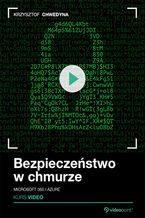 W realiach, w których hakerzy nieustannie adaptują metody pozyskiwania danych w nieautoryzowany sposób, aktualna wiedza i praktyka w zakresie cyberbezpieczeństwa są niezbędne. Szczególnie warto zwrócić uwagę na bezpieczeństwo w chmurze. Ponad 90 procent ataków na środowiska cloudowe wynika z błędnej konfiguracji tożsamości i uprawnień, co czyni Entra ID i Microsoft 365 krytycznymi obszarami do zabezpieczenia. Umiejętność wykrywania luk typu brak MFA czy błędne linki udostępniania w SharePoint pozwala nie tylko chronić firmowe dane, ale również zapobiegać potencjalnym stratom finansowym i wizerunkowym. Narzędzia używane przez pentesterów, takie jak BloodHound, GraphRunner i TokenTactics, umożliwiają symulowanie rzeczywistych ataków i analizę wewnętrznych relacji uprawnień, niedostrzegalnych na pierwszy rzut oka. Automatyzacja z Azure Runbook czy Omnispray, w połączeniu ze znajomością tokenów JWT, a także technik ataków password spray i token replay, pozwala lepiej zrozumieć skalę współczesnych zagrożeń i skutecznie zabezpieczać aplikacje i konta użytkowników. Aktualną wiedzę o cloud security znajdziesz w naszym szkoleniu. W dobie powszechnej migracji do chmury jej ochrona przestaje być opcją, a staje się obowiązkiem. Jednocześnie wiedza z tego zakresu otwiera nowe perspektywy zawodowe w red teams, blue teams, jak również działach compliance.
W realiach, w których hakerzy nieustannie adaptują metody pozyskiwania danych w nieautoryzowany sposób, aktualna wiedza i praktyka w zakresie cyberbezpieczeństwa są niezbędne. Szczególnie warto zwrócić uwagę na bezpieczeństwo w chmurze. Ponad 90 procent ataków na środowiska cloudowe wynika z błędnej konfiguracji tożsamości i uprawnień, co czyni Entra ID i Microsoft 365 krytycznymi obszarami do zabezpieczenia. Umiejętność wykrywania luk typu brak MFA czy błędne linki udostępniania w SharePoint pozwala nie tylko chronić firmowe dane, ale również zapobiegać potencjalnym stratom finansowym i wizerunkowym. Narzędzia używane przez pentesterów, takie jak BloodHound, GraphRunner i TokenTactics, umożliwiają symulowanie rzeczywistych ataków i analizę wewnętrznych relacji uprawnień, niedostrzegalnych na pierwszy rzut oka. Automatyzacja z Azure Runbook czy Omnispray, w połączeniu ze znajomością tokenów JWT, a także technik ataków password spray i token replay, pozwala lepiej zrozumieć skalę współczesnych zagrożeń i skutecznie zabezpieczać aplikacje i konta użytkowników. Aktualną wiedzę o cloud security znajdziesz w naszym szkoleniu. W dobie powszechnej migracji do chmury jej ochrona przestaje być opcją, a staje się obowiązkiem. Jednocześnie wiedza z tego zakresu otwiera nowe perspektywy zawodowe w red teams, blue teams, jak również działach compliance.- Videokurs 83 pkt
(39,90 zł najniższa cena z 30 dni)
83.30 zł
119.00 zł (-30%) -
Promocja
 Dzięki temu podręcznikowi odblokujesz swój potencjał i otworzysz drogę do kariery. Nauczysz się zarządzania kodem źródłowym przy użyciu Gita i skutecznego nawigowania po projektach. Odkryjesz zaawansowane techniki debugowania i dokumentowania kodu, co poprawi jego czytelność i ułatwi utrzymanie projektów. Zgłębisz też tajniki kryptografii, by zapewnić poufność i spójność danych na każdym etapie cyklu życia aplikacji. W książce nie zabrakło wnikliwego spojrzenia na nowoczesne zagadnienia, takie jak budowanie inteligentnych aplikacji korzystających z modeli LLM, wstrzykiwanie zależności, testowanie czy konteneryzacja za pomocą Dockera. Dzięki wskazówkom dotyczącym najlepszych praktyk architektury oprogramowania zaczniesz tworzyć solidne, skalowalne i łatwe w utrzymaniu aplikacje!
Dzięki temu podręcznikowi odblokujesz swój potencjał i otworzysz drogę do kariery. Nauczysz się zarządzania kodem źródłowym przy użyciu Gita i skutecznego nawigowania po projektach. Odkryjesz zaawansowane techniki debugowania i dokumentowania kodu, co poprawi jego czytelność i ułatwi utrzymanie projektów. Zgłębisz też tajniki kryptografii, by zapewnić poufność i spójność danych na każdym etapie cyklu życia aplikacji. W książce nie zabrakło wnikliwego spojrzenia na nowoczesne zagadnienia, takie jak budowanie inteligentnych aplikacji korzystających z modeli LLM, wstrzykiwanie zależności, testowanie czy konteneryzacja za pomocą Dockera. Dzięki wskazówkom dotyczącym najlepszych praktyk architektury oprogramowania zaczniesz tworzyć solidne, skalowalne i łatwe w utrzymaniu aplikacje!- PDF + ePub + Mobi
- Druk 76 pkt
(39,90 zł najniższa cena z 30 dni)
76.45 zł
139.00 zł (-45%) -
Promocja
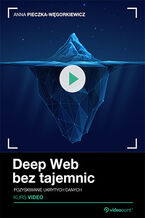 Deep Web to ogromna, ukryta część Internetu, która pozostaje niewidoczna dla tradycyjnych wyszukiwarek takich jak Google. Obejmuje zasoby nieindeksowane przez standardowe boty – bazy danych, repozytoria naukowe, archiwa statystyczne czy wyspecjalizowane wyszukiwarki branżowe. W przeciwieństwie do Dark Webu, Deep Web nie jest anonimową przestrzenią przestępczą, lecz miejscem dostępu do wartościowych i często darmowych informacji. Znajomość Deep Webu pozwala dotrzeć do wiarygodnych źródeł danych z zakresu demografii, zdrowia, edukacji, środowiska czy gospodarki. To również nieocenione narzędzie dla analityków, dziennikarzy, badaczy i osób podejmujących decyzje na podstawie twardych danych.
Deep Web to ogromna, ukryta część Internetu, która pozostaje niewidoczna dla tradycyjnych wyszukiwarek takich jak Google. Obejmuje zasoby nieindeksowane przez standardowe boty – bazy danych, repozytoria naukowe, archiwa statystyczne czy wyspecjalizowane wyszukiwarki branżowe. W przeciwieństwie do Dark Webu, Deep Web nie jest anonimową przestrzenią przestępczą, lecz miejscem dostępu do wartościowych i często darmowych informacji. Znajomość Deep Webu pozwala dotrzeć do wiarygodnych źródeł danych z zakresu demografii, zdrowia, edukacji, środowiska czy gospodarki. To również nieocenione narzędzie dla analityków, dziennikarzy, badaczy i osób podejmujących decyzje na podstawie twardych danych.- Videokurs 139 pkt
(34,90 zł najniższa cena z 30 dni)
139.30 zł
199.00 zł (-30%) -
Promocja
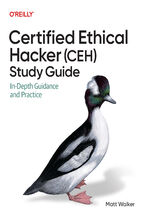 The CEH exam is not an enjoyable undertaking. This grueling, exhaustive, challenging, and taxing exam will either leave you better prepared to be the best cyber security professional you can be. But preparing for the exam itself needn't be that way. In this book, IT security and education professional Matt Walker will not only guide you through ev
The CEH exam is not an enjoyable undertaking. This grueling, exhaustive, challenging, and taxing exam will either leave you better prepared to be the best cyber security professional you can be. But preparing for the exam itself needn't be that way. In this book, IT security and education professional Matt Walker will not only guide you through ev-
- ePub + Mobi 186 pkt
(29,90 zł najniższa cena z 30 dni)
186.15 zł
219.00 zł (-15%) -
-
Promocja
 Tę książkę docenią specjaliści do spraw cyberbezpieczeństwa, którzy chcą zdobyć umiejętności zabezpieczania systemów AI. Znajdą w niej uporządkowaną prezentację wyników badań i najnowszych standardów branżowych, z uwzględnieniem klasyfikacji: MITRE, NIST i OWASP. W przewodniku omówiono strategię zabezpieczania AI już na etapie projektowania ― z wykorzystaniem modelowania zagrożeń, przy czym skoncentrowano się na integracji MLSecOps i LLMOps z systemami bezpieczeństwa przedsiębiorstwa. Dodatkowo przedstawiono przykłady wdrażania integracji ciągłej, strategii i narzędzi MLOps, a także mechanizmów kontroli bezpieczeństwa. Zaproponowano ponadto bazujący na klasycznych filarach NIST plan wzmacniania bezpieczeństwa AI w przedsiębiorstwie.
Tę książkę docenią specjaliści do spraw cyberbezpieczeństwa, którzy chcą zdobyć umiejętności zabezpieczania systemów AI. Znajdą w niej uporządkowaną prezentację wyników badań i najnowszych standardów branżowych, z uwzględnieniem klasyfikacji: MITRE, NIST i OWASP. W przewodniku omówiono strategię zabezpieczania AI już na etapie projektowania ― z wykorzystaniem modelowania zagrożeń, przy czym skoncentrowano się na integracji MLSecOps i LLMOps z systemami bezpieczeństwa przedsiębiorstwa. Dodatkowo przedstawiono przykłady wdrażania integracji ciągłej, strategii i narzędzi MLOps, a także mechanizmów kontroli bezpieczeństwa. Zaproponowano ponadto bazujący na klasycznych filarach NIST plan wzmacniania bezpieczeństwa AI w przedsiębiorstwie.- PDF + ePub + Mobi
- Druk 70 pkt
(39,90 zł najniższa cena z 30 dni)
70.95 zł
129.00 zł (-45%) -
Promocja
 Cechą dzisiejszego rynku IT jest ciągła zmiana. Zmieniają się urządzenia, modyfikacjom podlega również software. Jedną z przyczyn wprowadzania kolejnych unowocześnień jest dążenie do utrzymania odpowiedniego poziomu świadczenia usług biznesowych i wysokiego poziomu bezpieczeństwa. Służy temu na przykład zastosowanie monitoringu infrastruktury, czyli użycie odpowiednich narzędzi weryfikujących stan sieci, serwerów czy też aplikacji.
Cechą dzisiejszego rynku IT jest ciągła zmiana. Zmieniają się urządzenia, modyfikacjom podlega również software. Jedną z przyczyn wprowadzania kolejnych unowocześnień jest dążenie do utrzymania odpowiedniego poziomu świadczenia usług biznesowych i wysokiego poziomu bezpieczeństwa. Służy temu na przykład zastosowanie monitoringu infrastruktury, czyli użycie odpowiednich narzędzi weryfikujących stan sieci, serwerów czy też aplikacji.- PDF + ePub + Mobi
- Druk 37 pkt
(32,90 zł najniższa cena z 30 dni)
37.95 zł
69.00 zł (-45%)
O autorze książki
Adam Freeman - jest doświadczonym programistą, autorem wielu świetnie przyjętych książek o programowaniu w Javie. Tworzył również duże systemy rozproszone (platformy e-commerce). Zajmował stanowiska kierownicze w różnych firmach, wśród których są Netscape, Sun Microsystems, giełda NASDAQ i banki. Jest już na emeryturze, swój czas przeznacza na pisanie i bieganie na długie dystanse.
Adam Freeman, Allen Jones - pozostałe książki
-
Promocja
 Ta książka jest gruntownie uaktualnionym przewodnikiem po ASP.NET Core 3, przeznaczonym dla profesjonalnych programistów, którzy chcą w swoich projektach wykorzystać w pełni potencjał technologii Microsoftu. Wydanie zawiera kompletne i praktyczne omówienie ASP.NET Core 3. Znalazły się tu przydatne wskazówki dotyczące narzędzi potrzebnych podczas tworzenia nowoczesnych, skalowalnych aplikacji internetowych. Nowe funkcje — takie jak MVC 3, strony Razor, serwer Blazor i technologia Blazor WebAssembly — zostały dokładnie omówione i zaprezentowane na przykładach. Poruszono tutaj również takie tematy jak komponenty oprogramowania pośredniczącego, wbudowane usługi czy dołączanie modelu w żądaniu, a także zaprezentowano wiele bardziej zaawansowanych zagadnień, jak routing punktów końcowych i mechanizm wstrzykiwania zależności.
Ta książka jest gruntownie uaktualnionym przewodnikiem po ASP.NET Core 3, przeznaczonym dla profesjonalnych programistów, którzy chcą w swoich projektach wykorzystać w pełni potencjał technologii Microsoftu. Wydanie zawiera kompletne i praktyczne omówienie ASP.NET Core 3. Znalazły się tu przydatne wskazówki dotyczące narzędzi potrzebnych podczas tworzenia nowoczesnych, skalowalnych aplikacji internetowych. Nowe funkcje — takie jak MVC 3, strony Razor, serwer Blazor i technologia Blazor WebAssembly — zostały dokładnie omówione i zaprezentowane na przykładach. Poruszono tutaj również takie tematy jak komponenty oprogramowania pośredniczącego, wbudowane usługi czy dołączanie modelu w żądaniu, a także zaprezentowano wiele bardziej zaawansowanych zagadnień, jak routing punktów końcowych i mechanizm wstrzykiwania zależności.- PDF + ePub + Mobi
- Druk 109 pkt
(39,90 zł najniższa cena z 30 dni)
109.45 zł
199.00 zł (-45%) -
Promocja
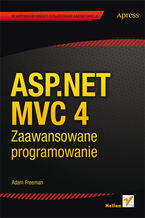 Lektura tej książki pozwoli Ci zapoznać się z technikami programowania w oparciu o testy (TDD). Przekonasz się, jak działa wzorzec MVC w praktyce. Ponadto uda Ci się szczegółowo poznać całą platformę ASP.NET MVC oraz zauważyć różnice, wady i zalety ASP.NET MVC względem klasycznego ASP.NET. Przekonasz się, jak zastosowanie filtrów może ułatwić Ci życie oraz jak niezwykle istotną kwestią jest zapewnienie bezpieczeństwa Twojej aplikacji. Książka ta jest doskonałym i kompletnym źródłem wiedzy na temat ASP.NET MVC. Obowiązkowa lektura dla każdego programisty tej platformy!
Lektura tej książki pozwoli Ci zapoznać się z technikami programowania w oparciu o testy (TDD). Przekonasz się, jak działa wzorzec MVC w praktyce. Ponadto uda Ci się szczegółowo poznać całą platformę ASP.NET MVC oraz zauważyć różnice, wady i zalety ASP.NET MVC względem klasycznego ASP.NET. Przekonasz się, jak zastosowanie filtrów może ułatwić Ci życie oraz jak niezwykle istotną kwestią jest zapewnienie bezpieczeństwa Twojej aplikacji. Książka ta jest doskonałym i kompletnym źródłem wiedzy na temat ASP.NET MVC. Obowiązkowa lektura dla każdego programisty tej platformy!- PDF + ePub + Mobi
- Druk 54 pkt
(34,90 zł najniższa cena z 30 dni)
54.45 zł
99.00 zł (-45%) -
Promocja
 O tym przekonasz się w trakcie lektury tej wyjątkowej książki. Jej autorzy przyjęli słuszną, zasadę, że dobry przykład mówi więcej niż kilka stron suchej teorii. Zobaczysz więc, jak wzorzec MVC sprawdza się w praktyce, jakie są jego zalety i wady oraz jak unikać typowych pułapek. Nauczysz się korzystać z filtrów, konfigurować kontrolery oraz projektować wydajny model. W dzisiejszych czasach bezpieczeństwo aplikacji stawiane jest na pierwszym miejscu, dlatego szczególną uwagę powinieneś zwrócić na rozdział poświęcony zabezpieczaniu stworzonego przez Ciebie rozwiązania. Ta książka to kompletna pozycja dla każdego programisty ASP.NET.
O tym przekonasz się w trakcie lektury tej wyjątkowej książki. Jej autorzy przyjęli słuszną, zasadę, że dobry przykład mówi więcej niż kilka stron suchej teorii. Zobaczysz więc, jak wzorzec MVC sprawdza się w praktyce, jakie są jego zalety i wady oraz jak unikać typowych pułapek. Nauczysz się korzystać z filtrów, konfigurować kontrolery oraz projektować wydajny model. W dzisiejszych czasach bezpieczeństwo aplikacji stawiane jest na pierwszym miejscu, dlatego szczególną uwagę powinieneś zwrócić na rozdział poświęcony zabezpieczaniu stworzonego przez Ciebie rozwiązania. Ta książka to kompletna pozycja dla każdego programisty ASP.NET.- PDF + ePub + Mobi
- Druk 54 pkt
(29,90 zł najniższa cena z 30 dni)
54.45 zł
99.00 zł (-45%) -
Promocja
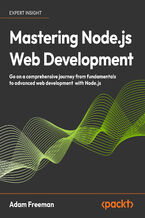 Explore Node.js with practical examples that will teach you how to utilize open-source packages for real-world solutions. Gain the skills to develop and deploy server-side applications that enhance your client-side projects.
Explore Node.js with practical examples that will teach you how to utilize open-source packages for real-world solutions. Gain the skills to develop and deploy server-side applications that enhance your client-side projects.-
- PDF + ePub 125 pkt
(29,90 zł najniższa cena z 30 dni)
125.10 zł
139.00 zł (-10%) -
-
Promocja
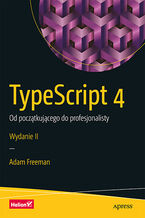 To drugie wydanie cenionego podręcznika dla początkujących programistów. Zawarty w nim materiał - podany jasno i przystępnie - pozwoli Ci w pełni poznać możliwości języka TypeScript 4. Naukę rozpoczniesz od zdobycia solidnych podstaw, a po przeanalizowaniu przejrzystych przykładów poznasz korzyści wynikające z używania TypeScriptu w rzeczywistych projektach. Nauczysz się pracy z API DOM, a także z takimi frameworkami jak Angular, Vue.js i React. Stopniowo będziesz nabierać wprawy w stosowaniu w praktyce najbardziej zaawansowanych funkcji. Dowiesz się też, z jakimi problemami najczęściej borykają się programiści TypeScript i jak je rozwiązywać. W efekcie uzyskasz bezpieczniejsze i bardziej produktywne środowisko do tworzenia aplikacji internetowych.
To drugie wydanie cenionego podręcznika dla początkujących programistów. Zawarty w nim materiał - podany jasno i przystępnie - pozwoli Ci w pełni poznać możliwości języka TypeScript 4. Naukę rozpoczniesz od zdobycia solidnych podstaw, a po przeanalizowaniu przejrzystych przykładów poznasz korzyści wynikające z używania TypeScriptu w rzeczywistych projektach. Nauczysz się pracy z API DOM, a także z takimi frameworkami jak Angular, Vue.js i React. Stopniowo będziesz nabierać wprawy w stosowaniu w praktyce najbardziej zaawansowanych funkcji. Dowiesz się też, z jakimi problemami najczęściej borykają się programiści TypeScript i jak je rozwiązywać. W efekcie uzyskasz bezpieczniejsze i bardziej produktywne środowisko do tworzenia aplikacji internetowych.- PDF + ePub + Mobi
- Druk 59 pkt
(39,90 zł najniższa cena z 30 dni)
59.94 zł
109.00 zł (-45%) -
Promocja
 To kolejne wydanie popularnego przewodnika, będącego starannie przygotowanym połączeniem opisu architekturalnego, specyfikacji technicznej i praktycznych wskazówek. Pozwala na niemal natychmiastowe rozpoczęcie pracy w Angularze. Na początek czeka Cię zapoznanie się ze wzorcem MVC, z jego zaletami i zastosowaniem. Następnie zaczniesz pisać funkcjonalne aplikacje - stopniowo będziesz przechodzić do coraz bardziej zaawansowanych i złożonych rozwiązań. Poszczególne przykłady zostały omówione w sposób jasny, zrozumiały i spójny. Dodatkowo w książce przedstawiono mnóstwo wskazówek i szczegółów, pozwalających na efektywną pracę i uzyskiwanie najlepszych efektów. Nie zabrakło także prezentacji najczęściej spotykanych problemów i metod ich rozwiązywania.
To kolejne wydanie popularnego przewodnika, będącego starannie przygotowanym połączeniem opisu architekturalnego, specyfikacji technicznej i praktycznych wskazówek. Pozwala na niemal natychmiastowe rozpoczęcie pracy w Angularze. Na początek czeka Cię zapoznanie się ze wzorcem MVC, z jego zaletami i zastosowaniem. Następnie zaczniesz pisać funkcjonalne aplikacje - stopniowo będziesz przechodzić do coraz bardziej zaawansowanych i złożonych rozwiązań. Poszczególne przykłady zostały omówione w sposób jasny, zrozumiały i spójny. Dodatkowo w książce przedstawiono mnóstwo wskazówek i szczegółów, pozwalających na efektywną pracę i uzyskiwanie najlepszych efektów. Nie zabrakło także prezentacji najczęściej spotykanych problemów i metod ich rozwiązywania.- PDF + ePub + Mobi
- Druk 81 pkt
(39,90 zł najniższa cena z 30 dni)
81.95 zł
149.00 zł (-45%) -
Promocja
 Ta książka jest przystępnym podręcznikiem, dzięki któremu poza uzyskaniem ważnych umiejętności odkryjesz najcenniejsze aspekty TypeScriptu. Rozpoczniesz od zdobycia solidnych podstaw, a po przeanalizowaniu przejrzystych przykładów poznasz korzyści wynikające z używania TypeScriptu. Stopniowo będziesz się uczyć stosować w praktyce najbardziej zaawansowane funkcje. Dowiesz się, jak stworzyć bezpieczniejsze i bardziej produktywne środowisko do tworzenia aplikacji internetowych, a także poznasz kilka popularnych frameworków, takich jak Node.js, Angular, React i Vue.js. Znajdziesz tu również informacje o najczęściej występujących problemach oraz sposobach ich rozwiązywania.
Ta książka jest przystępnym podręcznikiem, dzięki któremu poza uzyskaniem ważnych umiejętności odkryjesz najcenniejsze aspekty TypeScriptu. Rozpoczniesz od zdobycia solidnych podstaw, a po przeanalizowaniu przejrzystych przykładów poznasz korzyści wynikające z używania TypeScriptu. Stopniowo będziesz się uczyć stosować w praktyce najbardziej zaawansowane funkcje. Dowiesz się, jak stworzyć bezpieczniejsze i bardziej produktywne środowisko do tworzenia aplikacji internetowych, a także poznasz kilka popularnych frameworków, takich jak Node.js, Angular, React i Vue.js. Znajdziesz tu również informacje o najczęściej występujących problemach oraz sposobach ich rozwiązywania.- PDF + ePub + Mobi
- Druk 48 pkt
(29,90 zł najniższa cena z 30 dni)
48.95 zł
89.00 zł (-45%) -
Promocja
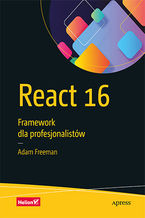 W książce przystępnie wyjaśniono zasady i techniki programowania w tym frameworku. Opisano szczegóły jego architektury oraz przedstawiono korzyści płynące z pracy z Reactem. Sporo miejsca poświęcono projektowaniu aplikacji oraz korzystaniu zarówno z samego frameworka, jak i towarzyszących mu narzędzi i najpopularniejszych bibliotek. Poszczególne zagadnienia są tu omawiane od podstaw, które następnie płynnie przechodzą do najbardziej zaawansowanych i wyszukanych technik programowania. Wszystkie informacje przedstawiono bardzo starannie, z zachowaniem ważnych szczegółów, dzięki czemu łatwo uzyskać wiedzę niezbędną do pisania aplikacji na wysokim, profesjonalnym poziomie. Nie zabrakło również wskazówek, dzięki którym można łatwo zdiagnozować najczęściej występujące problemy i skutecznie je rozwiązywać.
W książce przystępnie wyjaśniono zasady i techniki programowania w tym frameworku. Opisano szczegóły jego architektury oraz przedstawiono korzyści płynące z pracy z Reactem. Sporo miejsca poświęcono projektowaniu aplikacji oraz korzystaniu zarówno z samego frameworka, jak i towarzyszących mu narzędzi i najpopularniejszych bibliotek. Poszczególne zagadnienia są tu omawiane od podstaw, które następnie płynnie przechodzą do najbardziej zaawansowanych i wyszukanych technik programowania. Wszystkie informacje przedstawiono bardzo starannie, z zachowaniem ważnych szczegółów, dzięki czemu łatwo uzyskać wiedzę niezbędną do pisania aplikacji na wysokim, profesjonalnym poziomie. Nie zabrakło również wskazówek, dzięki którym można łatwo zdiagnozować najczęściej występujące problemy i skutecznie je rozwiązywać.- PDF + ePub + Mobi
- Druk 65 pkt
(39,90 zł najniższa cena z 30 dni)
65.45 zł
119.00 zł (-45%) -
Promocja
 Dzięki tej książce dowiesz się, czym jest Vue.js i jak rozpocząć z nim pracę, przekonasz się także, jakie ma możliwości. Nauczysz się budować dynamiczne aplikacje wykorzystujące właściwości nowoczesnych przeglądarek internetowych i urządzeń. Odkryjesz zalety wzorca MVC (model – widok – kontroler) i dowiesz się, jak zadziwiająco sprawnym językiem stał się JavaScript. Zapoznasz się z anatomią projektu Vue.js, z procesami kompilacji i transformacji oraz nabierzesz biegłości w posługiwaniu się zaawansowanymi funkcjami frameworka. Liczne przykłady pozwolą Ci na niemal natychmiastowe przetestowanie opisywanych zagadnień w praktyce. W rezultacie bardzo szybko będziesz przygotowany do tworzenia zaawansowanych, reaktywnych i dynamicznych aplikacji WWW!
Dzięki tej książce dowiesz się, czym jest Vue.js i jak rozpocząć z nim pracę, przekonasz się także, jakie ma możliwości. Nauczysz się budować dynamiczne aplikacje wykorzystujące właściwości nowoczesnych przeglądarek internetowych i urządzeń. Odkryjesz zalety wzorca MVC (model – widok – kontroler) i dowiesz się, jak zadziwiająco sprawnym językiem stał się JavaScript. Zapoznasz się z anatomią projektu Vue.js, z procesami kompilacji i transformacji oraz nabierzesz biegłości w posługiwaniu się zaawansowanymi funkcjami frameworka. Liczne przykłady pozwolą Ci na niemal natychmiastowe przetestowanie opisywanych zagadnień w praktyce. W rezultacie bardzo szybko będziesz przygotowany do tworzenia zaawansowanych, reaktywnych i dynamicznych aplikacji WWW!- PDF + ePub + Mobi
- Druk 54 pkt
(34,90 zł najniższa cena z 30 dni)
54.45 zł
99.00 zł (-45%) -
Promocja
 Książka rozpoczyna się od przedstawienia wzorca MVC i jego zalet. Ta wiedza następnie przydaje się do budowy własnego projektu za pomocą Angulara. Najpierw będzie to prosta, praktyczna aplikacja, a później zostaną przedstawione coraz bardziej zaawansowane funkcje. Każdy temat jasno i spójnie wyjaśniono, zamieszczając szczegóły konieczne do efektywnej pracy. Przedstawiono sposoby wykorzystywania różnych pożytecznych narzędzi, w tym frameworka Bootstrap, biblioteki Reactive Extensions czy frameworka Jasmine. Nie zabrakło objaśnień najczęściej występujących problemów oraz sposobów ich rozwiązywania.
Książka rozpoczyna się od przedstawienia wzorca MVC i jego zalet. Ta wiedza następnie przydaje się do budowy własnego projektu za pomocą Angulara. Najpierw będzie to prosta, praktyczna aplikacja, a później zostaną przedstawione coraz bardziej zaawansowane funkcje. Każdy temat jasno i spójnie wyjaśniono, zamieszczając szczegóły konieczne do efektywnej pracy. Przedstawiono sposoby wykorzystywania różnych pożytecznych narzędzi, w tym frameworka Bootstrap, biblioteki Reactive Extensions czy frameworka Jasmine. Nie zabrakło objaśnień najczęściej występujących problemów oraz sposobów ich rozwiązywania.- PDF + ePub + Mobi
- Druk 65 pkt
(39,90 zł najniższa cena z 30 dni)
65.45 zł
119.00 zł (-45%)
Ebooka "Programming .NET Security" przeczytasz na:
-
czytnikach Inkbook, Kindle, Pocketbook, Onyx Boox i innych
-
systemach Windows, MacOS i innych
-
systemach Windows, Android, iOS, HarmonyOS
-
na dowolnych urządzeniach i aplikacjach obsługujących formaty: PDF, EPub, Mobi
Masz pytania? Zajrzyj do zakładki Pomoc »
Szczegóły książki
- ISBN Ebooka:
- 978-05-965-5227-5, 9780596552275
- Data wydania ebooka :
-
2003-06-27
 Data wydania ebooka często jest dniem wprowadzenia tytułu do sprzedaży i może nie być równoznaczna
z datą wydania książki papierowej. Dodatkowe informacje możesz znaleźć w darmowym fragmencie.
Jeśli masz wątpliwości skontaktuj się z nami sklep@ebookpoint.pl.
Data wydania ebooka często jest dniem wprowadzenia tytułu do sprzedaży i może nie być równoznaczna
z datą wydania książki papierowej. Dodatkowe informacje możesz znaleźć w darmowym fragmencie.
Jeśli masz wątpliwości skontaktuj się z nami sklep@ebookpoint.pl.
- Język publikacji:
- angielski
- Rozmiar pliku ePub:
- 2.7MB
- Rozmiar pliku Mobi:
- 7.7MB
Dostępność produktu
Produkt nie został jeszcze oceniony pod kątem ułatwień dostępu lub nie podano żadnych informacji o ułatwieniach dostępu lub są one niewystarczające. Prawdopodobnie Wydawca/Dostawca jeszcze nie umożliwił dokonania walidacji produktu lub nie przekazał odpowiednich informacji na temat jego dostępności.
Spis treści książki
- Programming .NET Security
- SPECIAL OFFER: Upgrade this ebook with OReilly
- A Note Regarding Supplemental Files
- Preface
- How This Book Is Organized
- Part I: Fundamentals
- Part II: .NET Security
- Part III: .NET Cryptography
- Part IV: .NET Applications Frameworks
- Part V: API Quick Reference
- Who Should Read This Book
- Assumptions This Book Makes
- Conventions Used in This Book
- How to Contact Us
- How This Book Is Organized
- I. Fundamentals
- 1. Security Fundamentals
- 1.1. The Need for Security
- 1.2. Roles in Security
- 1.2.1. The Business Sponsor
- 1.2.2. The Architect
- 1.2.3. The Programmer
- 1.2.4. The Security Tester
- 1.2.5. The System Administrator
- 1.2.6. The User
- 1.2.7. The Hacker/Cracker
- 1.3. Understanding Software Security
- 1.3.1. Restricted Resources
- 1.3.2. Trust
- 1.3.3. Secrets
- 1.3.3.1. The lifetime of secrets
- 1.3.3.2. Protecting secrets
- 1.4. End-to-End Security
- 1.4.1. Real-World Trust Relationships
- 1.4.2. Side Channels
- 1.4.3. Physical Security
- 1.4.4. Third-Party Software
- 2. Assemblies
- 2.1. Assemblies Explained
- 2.2. Creating Assemblies
- 2.2.1. Creating a Single-File Assembly
- 2.2.2. Creating a Multifile Assembly
- 2.3. Shared Assemblies
- 2.4. Strong Names
- 2.4.1. Creating a Key Pair
- 2.4.2. Creating an Assembly Strong Name
- 2.4.2.1. Specifying the version and culture metadata
- 2.4.2.2. Specifying the key pair
- 2.4.2.3. Creating the strong name
- 2.4.2.4. Creating a strong name for a multifile assembly
- 2.4.3. Delayed Signing
- 2.4.4. Verifying a Strong Name
- 2.5. Publisher Certificates
- 2.5.1. Using the Global Assembly Cache
- 2.6. Decompiling Explained
- 2.6.1. Decompiling Assemblies
- 2.6.2. Protecting Against Decompilation
- 2.6.2.1. Obfuscation
- 2.6.2.2. Native compilation
- 3. Application Domains
- 3.1. Application Domains Explained
- 3.1.1. Application Isolation in the .NET Framework
- 3.1.2. Application Domain and Assembly Management
- 3.1.3. Assembly Isolation with Application Domains
- 3.1.4. Application Domains and Runtime Security
- 3.1.4.1. Assembly evidence and identity
- 3.1.4.2. Application domain evidence and identity
- 3.1.4.3. Application domains and security policy
- 3.1.4.4. Role-based security
- 3.1.4.5. Application domains and isolated storage
- 3.1.5. Application Domains and Application Configuration
- 3.1. Application Domains Explained
- 4. The Lifetime of a Secure Application
- 4.1. Designing a Secure .NET Application
- 4.1.1. Identifying Restricted Resources
- 4.1.2. Identifying Trust
- 4.1.3. Identifying Secrets
- 4.1.4. Failing Gracefully
- 4.2. Developing a Secure .NET Application
- 4.3. Security Testing a .NET Application
- 4.4. Deploying a .NET Application
- 4.5. Executing a .NET Application
- 4.6. Monitoring a .NET Application
- 4.1. Designing a Secure .NET Application
- 1. Security Fundamentals
- II. .NET Security
- 5. Introduction to Runtime Security
- 5.1. Runtime Security Explained
- 5.1.1. Running Unverifiable and Native Code
- 5.2. Introducing Role-Based Security
- 5.3. Introducing Code-Access Security
- 5.3.1. Evidence, Security Policy, and Permissions
- 5.3.2. Windows Security and Code-Access Security
- 5.4. Introducing Isolated Storage
- 5.1. Runtime Security Explained
- 6. Evidence and Code Identity
- 6.1. Evidence Explained
- 6.1.1. Sources and Types of Evidence
- 6.1.1.1. Host evidence
- 6.1.1.2. Assembly evidence
- 6.1.1. Sources and Types of Evidence
- 6.2. Programming Evidence
- 6.2.1. Introduction to Evidence Programming
- 6.2.2. Using the Evidence Class
- 6.2.3. Using the Standard Evidence Classes
- 6.2.3.1. The ApplicationDirectory class
- 6.2.3.2. The Hash class
- 6.2.3.3. The Publisher class
- 6.2.3.4. The Site class
- 6.2.3.5. The StrongName class
- 6.2.3.6. The Url class
- 6.2.3.7. The Zone class
- 6.2.4. Viewing Evidence
- 6.2.5. Assigning Evidence to Assemblies
- 6.2.6. Assigning Evidence to Application Domains
- 6.3. Extending the .NET Framework
- 6.3.1. Creating Custom Evidence
- 6.3.1.1. Defining the Author evidence class
- 6.3.1.2. Using the SecurityElement Class
- 6.3.1.3. Building the Author evidence class
- 6.3.2. Using Custom Evidence
- 6.3.2.1. Making the Author assembly a fully trusted assembly
- 6.3.2.2. Serializing evidence
- 6.3.2.3. Embedding evidence in an assembly
- 6.3.3. The Next Steps in Customization
- 6.3.1. Creating Custom Evidence
- 6.1. Evidence Explained
- 7. Permissions
- 7.1. Permissions Explained
- 7.1.1. Granting Permissions
- 7.1.2. Requesting Permissions
- 7.1.3. Permission Types
- 7.1.3.1. Code-access permissions
- 7.1.3.2. Identity permissions
- 7.1.4. Enforcing Code-Access Security
- 7.1.4.1. Stack walks explained
- 7.2. Programming Code-Access Security
- 7.2.1. Security Statement Syntax
- 7.2.1.1. Imperative security statements
- 7.2.1.2. Declarative security statements
- 7.2.2. Programming Permissions
- 7.2.2.1. Common permission class functionality
- 7.2.2.2. Using the SecurityPermission class
- 7.2.3. Programming Permission Sets
- 7.2.4. Programming Permission Requests
- 7.2.4.1. Requesting minimum permission
- 7.2.4.2. Requesting optional permissions
- 7.2.4.3. Refusing permissions
- 7.2.5. Programming Permission Demands
- 7.2.5.1. Demand
- 7.2.5.2. LinkDemands
- 7.2.5.3. Inheritance demands
- 7.2.6. Manipulating Stack Walks
- 7.2.6.1. Assert
- 7.2.6.2. Deny
- 7.2.6.3. PermitOnly
- 7.2.6.4. Reverting overrides
- 7.2.1. Security Statement Syntax
- 7.3. Extending the .NET Framework
- 7.3.1. Creating Custom Code-Access Permissions
- 7.3.1.1. Designing the RadioPermission class
- 7.3.1.2. Defining imports and assembly scope attributes
- 7.3.1.3. Defining the RadioAction enumeration
- 7.3.1.4. Defining the RadioPermission class
- 7.3.1.5. Implementing the IUnrestrictedPermission interface
- 7.3.1.6. Implementing the IPermission interface
- 7.3.1.7. Implementing the ISecurityEncodable interface
- 7.3.1.8. Defining the RadioPermissionAttribute class
- 7.3.1.9. Building the Radio.dll library
- 7.3.1.10. Using RadioPermission to enforce security
- 7.3.1. Creating Custom Code-Access Permissions
- 7.1. Permissions Explained
- 8. Security Policy
- 8.1. Security Policy Explained
- 8.1.1. Security Policy Levels
- 8.1.1.1. Code groups
- 8.1.1.2. Named permission sets
- 8.1.1.3. Fully trusted assemblies
- 8.1.2. Policy Resolution
- 8.1.2.1. Code group attributes
- 8.1.3. Configuring Security Policy
- 8.1.1. Security Policy Levels
- 8.2. Programming Security Policy
- 8.2.1. Programming Code Groups
- 8.2.1.1. Programming membership conditions
- 8.2.1.2. Programming policy statements
- 8.2.1.3. Creating code groups
- 8.2.2. Programming Policy Levels
- 8.2.2.1. Managing fully trusted assemblies
- 8.2.2.2. Managing named permission sets
- 8.2.2.3. Managing the code group tree
- 8.2.3. Programming the Security Manager
- 8.2.4. Programming Application Domain Policy
- 8.2.1. Programming Code Groups
- 8.3. Extending the .NET Framework
- 8.3.1. Custom Membership Conditions Explained
- 8.3.2. Defining the AuthorMembershipCondition Class
- 8.3.3. Building the AuthorMembershipCondition Assembly
- 8.3.4. Using the AuthorMembershipCondition Membership Condition
- 8.3.4.1. Installing security assemblies
- 8.3.4.2. Generating AuthorMembershipCondition XML
- 8.3.4.3. Configuring security policy
- 8.3.5. Testing Custom Membership Conditions
- 8.1. Security Policy Explained
- 9. Administering Code-Access Security
- 9.1. Default Security Policy
- 9.1.1. Security Policy Files
- 9.1.2. Named Permission Sets
- 9.1.3. Enterprise and User Policy Code Groups
- 9.1.4. Machine Policy Code Groups
- 9.1.5. Fully Trusted Assemblies
- 9.2. Inspecting Declarative Security Statements
- 9.3. Using the .NET Framework Configuration Tool
- 9.3.1. Managing Fully Trusted Assemblies
- 9.3.1.1. Adding a fully trusted assembly
- 9.3.1.2. Deleting a fully trusted assembly
- 9.3.2. Managing Named Permission Sets
- 9.3.2.1. Creating named permission sets
- 9.3.3. Managing Code Groups
- 9.3.3.1. Creating code groups
- 9.3.4. Other Security Policy Administration Options
- 9.3.1. Managing Fully Trusted Assemblies
- 9.4. Using the Code-Access Security Policy Tool
- 9.4.1. Controlling the Security System
- 9.4.1.1. Switching code-access security on and off
- 9.4.1.2. Switching execution permission checks on and off
- 9.4.2. Administering Policy Levels
- 9.4.2.1. Specifying the target policy level
- 9.4.2.2. Specifying the target code group
- 9.4.2.3. Managing fully trusted assemblies
- 9.4.2.4. Managing named permission sets
- 9.4.2.5. Managing code groups
- 9.4.3. Evaluating Security Policy
- 9.4.4. Forcing Security Changes
- 9.4.5. Resetting Security Policy
- 9.4.1. Controlling the Security System
- 9.1. Default Security Policy
- 10. Role-Based Security
- 10.1. Role-Based Security Explained
- 10.1.1. .NET Role-Based Security Explained
- 10.1.2. Comparing .NET Role-Based Security and Windows Security
- 10.2. Programming Role-Based Security
- 10.2.1. Introducing the IIdentity and IPrincipal Interfaces
- 10.2.2. Determining the Current Principal
- 10.2.3. Programming the Windows Role-Based Security Implementation
- 10.2.3.1. Configuring the current WindowsPrincipal
- 10.2.3.2. Impersonating Windows users
- 10.2.4. Making Role-Based Security Demands
- 10.2.4.1. Using imperative role-based security statements
- 10.2.4.2. Using declarative role-based security statements
- 10.2.5. Programming the Generic Role-Based Security Implementation
- 10.2.5.1. Configuring the current GenericPrincipal
- 10.1. Role-Based Security Explained
- 11. Isolated Storage
- 11.1. Isolated Storage Explained
- 11.1.1. Levels of Isolation
- 11.1.1.1. Determining user and code identity
- 11.1.1.2. Isolation by user and assembly
- 11.1.1.3. Isolation by user, assembly, and application domain
- 11.1.2. Limitations of Isolated Storage
- 11.1.1. Levels of Isolation
- 11.2. Programming Isolated Storage
- 11.2.1. Isolated Storage and Code-Access Security
- 11.2.2. Obtaining a Store
- 11.2.3. Creating Directories
- 11.2.4. Creating, Reading, and Writing Files
- 11.2.5. Searching for Files and Directories
- 11.2.6. Deleting Files and Directories
- 11.2.7. Deleting Stores
- 11.3. Administering Isolated Storage
- 11.3.1. Configuring Security Policy
- 11.3.1.1. Granting isolated storage permissions with Mscorcfg.msc
- 11.3.1.2. Granting isolated storage permissions with Caspol.exe
- 11.3.2. Managing Isolated Storage Stores
- 11.3.1. Configuring Security Policy
- 11.1. Isolated Storage Explained
- 5. Introduction to Runtime Security
- III. .NET Cryptography
- 12. Introduction to Cryptography
- 12.1. Cryptography Explained
- 12.1.1. Confidentiality
- 12.1.2. Integrity
- 12.1.3. Authentication
- 12.2. Cryptography Is Key Management
- 12.3. Cryptographic Attacks
- 12.3.1. Brute Force Attacks, Theft, and Guessing
- 12.3.2. Cryptanalysis
- 12.3.3. Software Bugs
- 12.1. Cryptography Explained
- 13. Hashing Algorithms
- 13.1. Hashing Algorithms Explained
- 13.1.1. Creating a Hash Code
- 13.1.2. Message Limits
- 13.1.3. Hash Code Length
- 13.1.4. The .NET Framework Hashing Algorithms
- 13.2. Programming Hashing Algorithms
- 13.2.1. The HashAlgorithm Class
- 13.2.2. Instantiating the Algorithm
- 13.2.3. Hashing Data from Memory
- 13.2.4. Hashing Streamed Data
- 13.2.5. Validating Hash Codes
- 13.3. Keyed Hashing Algorithms Explained
- 13.3.1. Creating the Keyed Hash Code
- 13.3.1.1. HMAC algorithms
- 13.3.1.2. Block cipher hash codes
- 13.3.2. The .NET Framework Keyed Hashing Algorithms
- 13.3.1. Creating the Keyed Hash Code
- 13.4. Programming Keyed Hashing Algorithms
- 13.4.1. The KeyedHashAlgorithm Class
- 13.4.2. Instantiating the Algorithm
- 13.4.3. Hashing Data and Validating Hash Codes
- 13.5. Extending the .NET Framework
- 13.5.1. The Alder32 Algorithm Explained
- 13.5.2. Defining the Abstract Class
- 13.5.3. Defining the Implementation Class
- 13.5.3.1. Creating the implementation class
- 13.5.3.2. Implementing the Initialize method
- 13.5.3.3. Implementing the HashCore and HashFinal methods
- 13.5.3.4. Completing the class
- 13.5.3.5. Testing the implementation
- 13.1. Hashing Algorithms Explained
- 14. Symmetric Encryption
- 14.1. Encryption Revisited
- 14.2. Symmetric Encryption Explained
- 14.2.1. Creating the Encrypted Data
- 14.2.2. Cipher Modes
- 14.2.2.1. Electronic Codebook mode
- 14.2.2.2. Cipher block chaining
- 14.2.2.3. Cipher feedback mode
- 14.2.3. Block Padding
- 14.2.4. Symmetric Encryption Key Lengths
- 14.2.5. The .NET Framework Encryption Algorithms
- 14.3. Programming Symmetrical Encryption
- 14.3.1. The SymmetricAlgorithm Class
- 14.3.2. Instantiating the Algorithm
- 14.3.3. Configuring the Algorithm
- 14.3.3.1. Block and key sizes
- 14.3.3.2. Cipher and padding modes
- 14.3.3.3. Keys and initialization vectors (IVs)
- 14.3.4. Encrypting and Decrypting Data
- 14.4. Extending the .NET Framework
- 14.4.1. The Extended Tiny Encryption Algorithm Explained
- 14.4.2. Defining the Abstract Class
- 14.4.3. Defining the Implementation Class
- 14.4.4. Defining an Abstract Transformation
- 14.4.5. Defining the Encryption Transformation
- 14.4.6. Defining the Decryption Transformation
- 15. Asymmetric Encryption
- 15.1. Asymmetric Encryption Explained
- 15.1.1. Creating Asymmetric Keys
- 15.1.2. Asymmetric Algorithm Security
- 15.1.3. Creating the Encrypted Data
- 15.1.3.1. Asymmetric data padding
- 15.2. Programming Asymmetrical Encryption
- 15.2.1. The AsymmetricAlgorithm class
- 15.2.2. The RSA class
- 15.2.3. The RSACryptoServiceProvider Class
- 15.2.4. Instantiating the Algorithm
- 15.2.5. Using RSA Keys
- 15.2.6. Encrypting and Decrypting Data
- 15.3. Extending the .NET Framework
- 15.3.1. The ElGamal Algorithm Explained
- 15.3.1.1. ElGamal key generation protocol
- 15.3.1.2. ElGamal encryption and decryption functions
- 15.3.2. Processing Large Integer Values
- 15.3.3. Defining the Abstract Class
- 15.3.4. Defining the Implementation Class
- 15.3.5. Defining the Abstract Cipher Function Class
- 15.3.6. Defining the Encryption Class
- 15.3.7. Defining the Decryption Class
- 15.3.8. Testing the Algorithm
- 15.3.1. The ElGamal Algorithm Explained
- 15.1. Asymmetric Encryption Explained
- 16. Digital Signatures
- 16.1. Digital Signatures Explained
- 16.1.1. Digital Signature Security
- 16.1.2. The .NET Framework Digital Signature Algorithms
- 16.1.3. Creating Digital Signatures
- 16.2. Programming Digital Signatures
- 16.2.1. Using the Abstract Class
- 16.2.2. Using the Implementation Class
- 16.2.3. Using the Signature Formatter Classes
- 16.3. Programming XML Signatures
- 16.3.1. XMLDSIG Explained
- 16.3.2. Signing an XML Document
- 16.3.2.1. Creating the reference
- 16.3.2.2. Creating the SignedXML
- 16.3.2.3. Setting the signing algorithm
- 16.3.2.4. Creating the signature
- 16.3.3. Embedding Objects in the Signature
- 16.3.4. Verifying an XML Signature
- 16.4. Extending the .NET Framework
- 16.4.1. The ElGamal Signature Functions Explained
- 16.4.2. Defining the Signature Function Class
- 16.4.3. Implementing the Managed Class Methods
- 16.4.4. Defining the PKCS #1 Helper Class
- 16.4.5. Defining the Signature Formatter Class
- 16.4.6. Defining the Signature Deformatter Class
- 16.4.7. Testing the Algorithm
- 16.1. Digital Signatures Explained
- 17. Cryptographic Keys
- 17.1. Cryptographic Keys Explained
- 17.1.1. Understanding Key Complexity
- 17.1.2. Exchanging Symmetric Algorithm Keys
- 17.2. Programming Cryptographic Keys
- 17.2.1. Creating Keys
- 17.2.1.1. Using the algorithm classes
- 17.2.1.2. Using a random number generator
- 17.2.1.3. Using a key-derivation protocol
- 17.2.2. Using Key Persistence
- 17.2.3. Key Exchange Formatting
- 17.2.1. Creating Keys
- 17.3. Extending the .NET Framework
- 17.3.1. ElGamal Key Exchange Explained
- 17.3.2. Defining the Key Exchange Formatter
- 17.3.3. Defining the Key Exchange Deformatter
- 17.1. Cryptographic Keys Explained
- 12. Introduction to Cryptography
- IV. .NET Application Frameworks
- 18. ASP.NET Application Security
- 18.1. ASP.NET Security Explained
- 18.1.1. ASP.NET Security Overview
- 18.1.2. ASP.NET Configuration Files
- 18.1.2.1. ASP.NET security-related configuration elements
- 18.1.2.2. Using <location> elements
- 18.2. Configuring the ASP.NET Worker Process Identity
- 18.3. Authentication
- 18.3.1. Configuring IIS Authentication Modes
- 18.3.2. No Authentication
- 18.3.3. Windows Authentication
- 18.3.4. Forms Authentication
- 18.3.4.1. Configuring Forms authentication
- 18.3.4.2. Creating the logon page
- 18.3.4.3. Creating the protected page
- 18.3.5. Passport Authentication
- 18.4. Authorization
- 18.4.1. File Authorization
- 18.4.2. URL Authorization
- 18.5. Impersonation
- 18.6. ASP.NET and Code-Access Security
- 18.1. ASP.NET Security Explained
- 19. COM+ Security
- 19.1. COM+ Security Explained
- 19.1.1. COM+ Role-Based Security
- 19.1.2. COM+ Process-Access Security
- 19.1.2.1. Authentication
- 19.1.2.2. Impersonation
- 19.2. Programming COM+ Security
- 19.2.1. Creating the Serviced Component
- 19.2.2. Specifying the COM+ Application Type
- 19.2.3. Applying the Security Attributes
- 19.2.3.1. The ApplicationAccessControl attribute
- 19.2.3.2. The ComponentAccessControl Attribute
- 19.2.3.3. The SecurityRole attribute
- 19.2.3.4. The SecureMethod attribute
- 19.2.4. Compiling and Installing the COM+ Application
- 19.3. Administering COM+ Security
- 19.3.1. Viewing the COM+ Catalogue
- 19.3.2. Populating COM+ Application Roles
- 19.3.3. Assessing and Assigning Role Scope
- 19.3.4. Managing COM+ Security
- 19.3.4.1. Managing the application
- 19.3.4.2. Managing the component
- 19.1. COM+ Security Explained
- 20. The Event Log Service
- 20.1. The Event Log Service Explained
- 20.1.1. Event Logs
- 20.1.2. Event Sources
- 20.1.3. Event Structure
- 20.1.3.1. Event source name
- 20.1.3.2. Message
- 20.1.3.3. Event type
- 20.1.3.4. Event identifier and event category
- 20.1.3.5. Binary data
- 20.2. Programming the Event Log Service
- 20.2.1. Querying the Event Log System
- 20.2.2. Using Event Sources
- 20.2.3. Reading Event Logs
- 20.2.4. Writing Events
- 20.2.5. Using Custom Event Logs
- 20.2.6. Monitoring Event Logs
- 20.1. The Event Log Service Explained
- 18. ASP.NET Application Security
- V. API Quick Reference
- 21. How to Use This Quick Reference
- 21.1. Finding a Quick-Reference Entry
- 21.2. Reading a Quick-Reference Entry
- 21.2.1. Type Name, Namespace, Assembly, Type Category, and Flags
- 21.2.2. Description
- 21.2.3. Synopsis
- 21.2.3.1. Member availability and flags
- 21.2.3.2. Functional grouping of members
- 21.2.4. Class Hierarchy
- 21.2.5. Cross-References
- 21.2.6. A Note About Type Names
- 22. Converting from C# to VB Syntax
- 22.1. General Considerations
- 22.2. Classes
- 22.3. Structures
- 22.4. Interfaces
- 22.5. Class, Structure, and Interface Members
- 22.5.1. Fields
- 22.5.2. Methods
- 22.5.3. Properties
- 22.5.4. Events
- 22.6. Delegates
- 22.7. Enumerations
- 23. The System.Security Namespace
- AllowPartiallyTrustedCallersAttribute
- CodeAccessPermission
- IEvidenceFactory
- IPermission
- ISecurityEncodable
- ISecurityPolicyEncodable
- IStackWalk
- NamedPermissionSet
- PermissionSet
- PolicyLevelType
- SecurityElement
- SecurityException
- SecurityManager
- SecurityZone
- SuppressUnmanagedCodeSecurityAttribute
- UnverifiableCodeAttribute
- VerificationException
- XmlSyntaxException
- 24. The System.Security.Cryptography Namespace
- AsymmetricAlgorithm
- AsymmetricKeyExchangeDeformatter
- AsymmetricKeyExchangeFormatter
- AsymmetricSignatureDeformatter
- AsymmetricSignatureFormatter
- CipherMode
- CryptoAPITransform
- CryptoConfig
- CryptographicException
- CryptographicUnexpectedOperationException
- CryptoStream
- CryptoStreamMode
- CspParameters
- CspProviderFlags
- DeriveBytes
- DES
- DESCryptoServiceProvider
- DSA
- DSACryptoServiceProvider
- DSAParameters
- DSASignatureDeformatter
- DSASignatureFormatter
- FromBase64Transform
- FromBase64TransformMode
- HashAlgorithm
- HMACSHA1
- ICryptoTransform
- KeyedHashAlgorithm
- KeySizes
- MACTripleDES
- MaskGenerationMethod
- MD5
- MD5CryptoServiceProvider
- PaddingMode
- PasswordDeriveBytes
- PKCS1MaskGenerationMethod
- RandomNumberGenerator
- RC2
- RC2CryptoServiceProvider
- Rijndael
- RijndaelManaged
- RNGCryptoServiceProvider
- RSA
- RSACryptoServiceProvider
- RSAOAEPKeyExchangeDeformatter
- RSAOAEPKeyExchangeFormatter
- RSAParameters
- RSAPKCS1KeyExchangeDeformatter
- RSAPKCS1KeyExchangeFormatter
- RSAPKCS1SignatureDeformatter
- RSAPKCS1SignatureFormatter
- SHA1
- SHA1CryptoServiceProvider
- SHA1Managed
- SHA256
- SHA256Managed
- SHA384
- SHA384Managed
- SHA512
- SHA512Managed
- SignatureDescription
- SymmetricAlgorithm
- ToBase64Transform
- TripleDES
- TripleDESCryptoServiceProvider
- 25. The System.Security.Cryptography.X509Certificates Namespace
- X509Certificate
- X509CertificateCollection
- X509CertificateCollection.X509CertificateEnumerator
- 26. The System.Security.Cryptography.Xml Namespace
- DataObject
- DSAKeyValue
- KeyInfo
- KeyInfoClause
- KeyInfoName
- KeyInfoNode
- KeyInfoRetrievalMethod
- KeyInfoX509Data
- Reference
- RSAKeyValue
- Signature
- SignedInfo
- SignedXml
- Transform
- TransformChain
- XmlDsigBase64Transform
- XmlDsigC14NTransform
- XmlDsigC14NWithCommentsTransform
- XmlDsigEnvelopedSignatureTransform
- XmlDsigXPathTransform
- XmlDsigXsltTransform
- 27. The System.Security.Permissions Namespace
- CodeAccessSecurityAttribute
- EnvironmentPermission
- EnvironmentPermissionAccess
- EnvironmentPermissionAttribute
- FileDialogPermission
- FileDialogPermissionAccess
- FileDialogPermissionAttribute
- FileIOPermission
- FileIOPermissionAccess
- FileIOPermissionAttribute
- IsolatedStorageContainment
- IsolatedStorageFilePermission
- IsolatedStorageFilePermissionAttribute
- IsolatedStoragePermission
- IsolatedStoragePermissionAttribute
- IUnrestrictedPermission
- PermissionSetAttribute
- PermissionState
- PrincipalPermission
- PrincipalPermissionAttribute
- PublisherIdentityPermission
- PublisherIdentityPermissionAttribute
- ReflectionPermission
- ReflectionPermissionAttribute
- ReflectionPermissionFlag
- RegistryPermission
- RegistryPermissionAccess
- RegistryPermissionAttribute
- ResourcePermissionBase
- ResourcePermissionBaseEntry
- SecurityAction
- SecurityAttribute
- SecurityPermission
- SecurityPermissionAttribute
- SecurityPermissionFlag
- SiteIdentityPermission
- SiteIdentityPermissionAttribute
- StrongNameIdentityPermission
- StrongNameIdentityPermissionAttribute
- StrongNamePublicKeyBlob
- UIPermission
- UIPermissionAttribute
- UIPermissionClipboard
- UIPermissionWindow
- UrlIdentityPermission
- UrlIdentityPermissionAttribute
- ZoneIdentityPermission
- ZoneIdentityPermissionAttribute
- 28. The System.Security.Policy Namespace
- AllMembershipCondition
- ApplicationDirectory
- ApplicationDirectoryMembershipCondition
- CodeGroup
- Evidence
- FileCodeGroup
- FirstMatchCodeGroup
- Hash
- HashMembershipCondition
- IIdentityPermissionFactory
- IMembershipCondition
- NetCodeGroup
- PermissionRequestEvidence
- PolicyException
- PolicyLevel
- PolicyStatement
- PolicyStatementAttribute
- Publisher
- PublisherMembershipCondition
- Site
- SiteMembershipCondition
- StrongName
- StrongNameMembershipCondition
- UnionCodeGroup
- Url
- UrlMembershipCondition
- Zone
- ZoneMembershipCondition
- 29. The System.Security.Principal Namespace
- GenericIdentity
- GenericPrincipal
- IIdentity
- IPrincipal
- PrincipalPolicy
- WindowsAccountType
- WindowsBuiltInRole
- WindowsIdentity
- WindowsImpersonationContext
- WindowsPrincipal
- 21. How to Use This Quick Reference
- Index
- About the Authors
- Colophon
- SPECIAL OFFER: Upgrade this ebook with OReilly
O'Reilly Media - inne książki
-
Promocja
 The potential of machine learning today is extraordinary, yet many aspiring developers and tech professionals find themselves daunted by its complexity. Whether you're looking to enhance your skill set and apply machine learning to real-world projects or are simply curious about how AI systems function, this book is your jumping-off place. With an
The potential of machine learning today is extraordinary, yet many aspiring developers and tech professionals find themselves daunted by its complexity. Whether you're looking to enhance your skill set and apply machine learning to real-world projects or are simply curious about how AI systems function, this book is your jumping-off place. With an-
- ePub + Mobi 254 pkt
(245,65 zł najniższa cena z 30 dni)
254.15 zł
299.00 zł (-15%) -
-
Promocja
 Stuck in a coding conundrum? Whether you're an advanced beginner, an intermediate developer, or a curious newcomer, the complexities of coding can often feel like a labyrinth with no exit. With Python, however, you can start writing real code quickly—but where should you start? In this updated third edition, Bill Lubanovic acts as your personal gu
Stuck in a coding conundrum? Whether you're an advanced beginner, an intermediate developer, or a curious newcomer, the complexities of coding can often feel like a labyrinth with no exit. With Python, however, you can start writing real code quickly—but where should you start? In this updated third edition, Bill Lubanovic acts as your personal gu-
- ePub + Mobi 143 pkt
(29,90 zł najniższa cena z 30 dni)
143.65 zł
169.00 zł (-15%) -
-
Promocja
 AI-assisted coding and cloud-based tools are already transforming how modern applications are built. Bolt.new, a powerful in-browser AI agent from StackBlitz, streamlines the development process, allowing you to prototype quickly, debug intelligently, and launch confidently—no local setup required. Whether you're new to full stack development or lo
AI-assisted coding and cloud-based tools are already transforming how modern applications are built. Bolt.new, a powerful in-browser AI agent from StackBlitz, streamlines the development process, allowing you to prototype quickly, debug intelligently, and launch confidently—no local setup required. Whether you're new to full stack development or lo-
- ePub + Mobi 169 pkt
(29,90 zł najniższa cena z 30 dni)
169.14 zł
199.00 zł (-15%) -
-
Promocja
 AI is transforming software development, shifting programmers from writing code to collaborating with AI in an intent-driven workflow. Vibe coding—a prompt-first, exploratory approach where you describe what you want in natural language and let a large language model fill in the blanks—represents a radical shift in the developer's role from writing
AI is transforming software development, shifting programmers from writing code to collaborating with AI in an intent-driven workflow. Vibe coding—a prompt-first, exploratory approach where you describe what you want in natural language and let a large language model fill in the blanks—represents a radical shift in the developer's role from writing-
- ePub + Mobi 203 pkt
(29,90 zł najniższa cena z 30 dni)
203.15 zł
239.00 zł (-15%) -
-
Promocja
 Whether it's to adhere to regulations, access markets by meeting specific standards, or devise data analytics and AI strategies, companies today are busy implementing metadata repositories—metadata tools about the data, information, and knowledge in your company. Until now, most of these repositories have been implemented in isolation from one anot
Whether it's to adhere to regulations, access markets by meeting specific standards, or devise data analytics and AI strategies, companies today are busy implementing metadata repositories—metadata tools about the data, information, and knowledge in your company. Until now, most of these repositories have been implemented in isolation from one anot-
- ePub + Mobi 228 pkt
(29,90 zł najniższa cena z 30 dni)
228.65 zł
269.00 zł (-15%) -
-
Promocja
 In today's environment of partial attention and isolating remote work, few things are more satisfying than group experiences that produce powerful, meaningful connections and output. But this kind of enlivening, collective work doesn't happen by chance. It must be consciously designed and purposefully activated--;in a team, an organization, and a c
In today's environment of partial attention and isolating remote work, few things are more satisfying than group experiences that produce powerful, meaningful connections and output. But this kind of enlivening, collective work doesn't happen by chance. It must be consciously designed and purposefully activated--;in a team, an organization, and a c-
- ePub + Mobi 143 pkt
(29,90 zł najniższa cena z 30 dni)
143.65 zł
169.00 zł (-15%) -
-
Promocja
 Feeling overwhelmed by the volume of data in your research? Sifting through massive amounts of data to find useful insights is becoming increasingly difficult in drug discovery, genetics, and healthcare. Enter the era of generative AI with LangChain, whose groundbreaking tools are changing the way life scientists and researchers operate. In this g
Feeling overwhelmed by the volume of data in your research? Sifting through massive amounts of data to find useful insights is becoming increasingly difficult in drug discovery, genetics, and healthcare. Enter the era of generative AI with LangChain, whose groundbreaking tools are changing the way life scientists and researchers operate. In this g-
- ePub + Mobi 228 pkt
(29,90 zł najniższa cena z 30 dni)
228.65 zł
269.00 zł (-15%) -
-
Promocja
 An application programming interface (API) enables data exchange in systems such as web applications, microservices, and IoT devices. In this hands-on book, authors Lukasz Dynowski and Marcin Dulak show software developers and architects how to design and implement REST, GraphQL, gRPC, webhooks, WebSocket, messaging APIs, and more. This book look
An application programming interface (API) enables data exchange in systems such as web applications, microservices, and IoT devices. In this hands-on book, authors Lukasz Dynowski and Marcin Dulak show software developers and architects how to design and implement REST, GraphQL, gRPC, webhooks, WebSocket, messaging APIs, and more. This book look-
- ePub + Mobi 203 pkt
(29,90 zł najniższa cena z 30 dni)
203.15 zł
239.00 zł (-15%) -
-
Promocja
 Here's the thing about large language models: they don't play by the old rules. Traditional MLOps completely falls apart when you're dealing with GenAI. The model hallucinates, security assumptions crumble, monitoring breaks, and agents can't operate. Suddenly you're in uncharted territory. That's exactly why LLMOps has emerged as its own disciplin
Here's the thing about large language models: they don't play by the old rules. Traditional MLOps completely falls apart when you're dealing with GenAI. The model hallucinates, security assumptions crumble, monitoring breaks, and agents can't operate. Suddenly you're in uncharted territory. That's exactly why LLMOps has emerged as its own disciplin-
- ePub + Mobi 228 pkt
(29,90 zł najniższa cena z 30 dni)
228.65 zł
269.00 zł (-15%) -
-
Promocja
 Eager to learn AI and machine learning but unsure where to start? Laurence Moroney's hands-on, code-first guide demystifies complex AI concepts without relying on advanced mathematics. Designed for programmers, it focuses on practical applications using PyTorch, helping you build real-world models without feeling overwhelmed.From computer vision an
Eager to learn AI and machine learning but unsure where to start? Laurence Moroney's hands-on, code-first guide demystifies complex AI concepts without relying on advanced mathematics. Designed for programmers, it focuses on practical applications using PyTorch, helping you build real-world models without feeling overwhelmed.From computer vision an-
- ePub + Mobi 228 pkt
(29,90 zł najniższa cena z 30 dni)
228.65 zł
269.00 zł (-15%) -
Dzięki opcji "Druk na żądanie" do sprzedaży wracają tytuły Grupy Helion, które cieszyły sie dużym zainteresowaniem, a których nakład został wyprzedany.
Dla naszych Czytelników wydrukowaliśmy dodatkową pulę egzemplarzy w technice druku cyfrowego.
Co powinieneś wiedzieć o usłudze "Druk na żądanie":
- usługa obejmuje tylko widoczną poniżej listę tytułów, którą na bieżąco aktualizujemy;
- cena książki może być wyższa od początkowej ceny detalicznej, co jest spowodowane kosztami druku cyfrowego (wyższymi niż koszty tradycyjnego druku offsetowego). Obowiązująca cena jest zawsze podawana na stronie WWW książki;
- zawartość książki wraz z dodatkami (płyta CD, DVD) odpowiada jej pierwotnemu wydaniu i jest w pełni komplementarna;
- usługa nie obejmuje książek w kolorze.
Masz pytanie o konkretny tytuł? Napisz do nas: sklep@ebookpoint.pl
Książka drukowana


Postaraj się złożyć zamówienie do godziny 13:00, w dniach:
18. grudnia (Poczta Polska),
19. grudnia (Paczka w Ruchu),
22. grudnia (paczkomaty InPost),
22. grudnia (DPD punkty).
22. grudnia (DPD Kurier).







Oceny i opinie klientów: Programming .NET Security Adam Freeman, Allen Jones
(0)